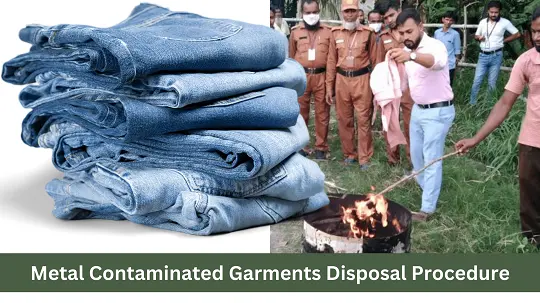Metal Contaminated Garments Disposal Procedure in the Garments Industry
To safely and effectively dispose of garments contaminated with metal to prevent any harm to workers, or the environment, and to comply with relevant regulations. QAD Head & Compliance head/ HR Admin are responsible for doing metal contamination garments as a periodical routine. In this article, we discuss the step-by-step process of the metal contaminated garments disposal in the garments industry.
Metal Contaminated Garments Disposal Procedure is an important document for the garments manufacturing industry. It is critical for product safety, we have to maintain it to save our customer reputation in the market.

Metal Contaminated Garments Disposal Procedure step by step in the Garments Industry
1. Preparation:
- Gather all necessary materials and equipment in a designated area.
- Ensure that all personnel involved are wearing appropriate personal protective equipment (PPE) including gloves, goggles, and masks.
2. Segregation:
- Identify and segregate the garments contaminated with metal. These could be garments with metal fragments, broken zippers, or any other form of metal contamination.
- Keep the contaminated garments separate from other non-contaminated garments to prevent further spreading of the contamination.
3. Packaging:
- Place the metal-contaminated garments into heavy-duty trash bags. Double-bagging might be necessary if the garments are sharp or particularly contaminated.
- Seal the bags tightly using sealing tape to prevent any leaks or spills.
4. Labelling:
- a. Clearly label the bags as “Metal-Contaminated Garments for Disposal.”
- b. Include any relevant information required by regulations on the labels.
5. Temporary Storage:
- a. Store the labeled bags in a secure and designated storage area to await proper disposal. This area should be inaccessible to unauthorized personnel.
6. Arranging Disposal:
- Contact a licensed waste disposal company that specializes in hazardous or contaminated waste disposal. After 01-year the Metal contamination box will be opened & all the contaminated garments will be destroyed by burn.
- Provide them with accurate information about the nature and extent of the contamination to ensure they handle the disposal properly. If the 01-year box is full then we break our normal procedure & open the box in front of the responsible person & destroy all the garments of the contamination box and keep the record. If after 01-year the box is empty we also reopen the box & keep a record of the periodical reopen done but haven’t any product.
7. Transportation:
- If necessary, use appropriate equipment such as a forklift to transport the bags to the disposal collection point or loading area.
8. Disposal:
- Follow the disposal company’s guidelines for handing over the contaminated garments.
- Ensure that the disposal is done in compliance with relevant environmental and regulatory guidelines.
9. Documentation:
- Maintain records of the disposal process, including the dates, quantities, disposal company details, and any associated paperwork or receipts.
10. Clean-Up:
- Thoroughly clean the designated disposal area and any equipment used in the process.
- Dispose of any used PPE according to regulations.
Materials Needed:
- Metal-contaminated garments
- Protective clothing (gloves, goggles, masks, etc.)
- Heavy-duty trash bags
- Sealing tape
- Collection bins/containers
- Designated disposal area
- Forklift or similar equipment (if needed)
- Relevant regulatory guidelines
Responsible Persons like the Quality Manager, HR head, and merchandising should be present when destroying metal contamination garments as per the above rule. Metal contamination garments keeping record and Metal contamination garments disposal log must be maintained.
- You would love to read: Needle Management Procedures in the Garments Industry
- Metal Detection Process: Calibration and Metal Detector Maintenance in the Garments Industry
